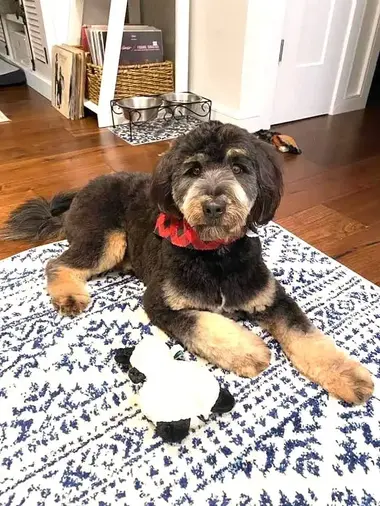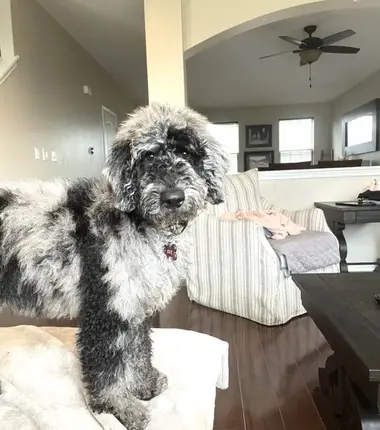Introduction
Groodle Coat Colors or pattern is often the first thing that catches our eye. There’s no doubt that color should be striking and eye-catching. Breeders created the famous Groodle hybrid breed by crossing a Golden Retriever with a Poodle, known for their social nature, intelligence, and hypoallergenic coats. They have a wide range of coat colors which they adopt by different genes.
Understanding Groodle Coat Colors Genetics
Different groodle coat colors contain various combinations of genes. Groodles are found in different colors and shades due to their genetic diversity inherited from their parent breeds. Golden Retrievers are in typical three colors cream, gold, and red. While Poodles have a wide range of coat colors they are commonly found in 10 different shades; apricot, black, blue, brown, cream, gray, red, silver, silver beige, and white. The fascinating combination of genetic factors results in a diverse range of Groodle coat colors and patterns.
Basic Genetic Principles
Dominant and Recessive Genes:
A combination of dominant and recessive genes in dogs determines coat colors. Dominant genes often express while recessive genes can be carried without being visible.
Eumelanin and Phaeomelanin:
Eumelanin and Phaeomelanin are two significant pigments, that influence Groodle coat colors. Eumelanin produces black or brown colors, while phaeomelanin produces red, yellow, or creamy shades.
Common Groodle Coat Colors
Cream Groodles:

Cream Groodles have a light, nearly white coat with a minute golden shade, and reflect the Golden Retriever. This color has many variations, the cream groodle may have a pink or dark nose and different shades of cream. Their fur is so soft and wavy. Diluting red or apricot genes usually produces the cream shade, resulting in a lighter color.
Apricot Groodles:

Apricot Groodles have warm and peachy coats that can fluctuate between lighter and deeper shades, although most dogs have this color throughout their body some dogs might have slightly lighter or darker areas. The American Kennel Club officially recognizes apricot as a Poodle coat color. The apricot color results from phaeomelanin pigment and can change by dilution of genes’ expression.
Red Groodles:

Red Groodles adopt Golden Retriever’s golden hue but with some intense pigmentation which results in a deep reddish-brown coat. Dark poodle and average color Golden Retriever mostly results in eye-catching red coat groodle The red coat color is because of a high concentration of phaeomelanin. A breed between two red-coated Groodles often produces offspring with a similar vibrant coat.
Black Groodles:

Black Groodles have a solid and glossy black coat with several curls or waves mostly depending on the Poodle influence. It is the rare coat color because to achieve this both parents should have recessive black color genes. It is most likely in the second or third generations. The black coat color in Groodles is due to dominant eumelanin genes, black as a dominant trait is becoming a common color among Groodles.
Chocolate Groodles:

Chocolate Groodles due to their rich and dark brown coats can fluctuate from milk chocolate to a deep and solid brown, nearly black shade. The AKC also recognizes this color as the official color of Poodles and a popular coat color among poodles.
Gray Groodles:

Gray color is because of the black line and from the Poodle heritage. Breeders can achieve this rare coat color through several generations of breeding. When they are born their color is so dark but after 6 weeks they show a slight gray hue. Gray groodles may experience color changes during their first two years of life. Some may retain their original color on their face and ears, resulting in a cute two-tone look.
Blue Groodles:

Blue Groodle is a result of grey and black colors. Sometimes, they look similar to gray ones. But they are slightly darker and steely. They have both darker and lighter patches on their coat. This is a rare color among Groodles. Like gray Groodles, in the first two years of their lives, changes occur in their coat color. Some blue-coated puppies may lighten to a clear color as they mature, and others remain with the blue color.
Silver Groodles:

Silver is a mixture of gray and blue tones. These Groodles are also born with dark color and gain silver color when they are around 2 years old. Their color fluctuations are noticeable from around 6 to 10 weeks. You can often find white or silver hairs between their toes. Their change from black to silver coat is majestic and your puppy will look so different when it is done.
White Groodle:

White groodles are because of a specific genetic trait that is not present in Golden Retrievers. This means that white puppies can only be produced through careful breeding. Unlike cream, white is a permanent color, so, white groodles will maintain their white coat throughout their lives. They are not completely white. They have soft patches of cream or apricot color. But they look white when looking from a distance.
Tan Groodles:
Groodles often inherit their tan color from their Golden Retriever parent. This color is due to diluted red pigment. It generally includes shades of cream, white, or pale apricot. This combination creates a golden tan hue.
Groodle Coat Colors Patterns
Parti Groodles:

Parti Groodles have a playful mix of two different colors. They have a predominantly white coat with patches of another color such as black, chocolate, or apricot. The patches can be of different shapes and various sizes. Parti coloring is a distinct feature that results from a specific gene that causes white spotting. To produce a parti Groodle, both parents must possess the parti-color gene.
Phantom Groodles:

Phantom Groodles have a distinct coat pattern that bears a striking resemblance to a Doberman. They have primary coat colors (black or chocolate) and secondary patches above the eyes, on the side of the muzzles, chest, legs, and under the tail. This coloring results from a combination of specific genes. It dictates both primary coat color and secondary markings.
Merle Groodles:

Merle Groodles contain stunning appearance with patches of distinct colors, with blue or odd-colored eyes, this pattern can be seen in different base colors such as blue merle (black and gray) and red merle (red and cream). The pattern results from a dominant gene that modifies base coat colors, causing characteristic marbling. Although this coat color is beautiful, merle genes can cause blindness and deafness when merle genes are bred together. Therefore, only breeders with a deep understanding of their genetics breed them.
Tuxedo Groodles:
Tuxedo patterning is a type of parti-color pattern where the white markings are primarily located on the chest and legs, creating a visual effect that resembles a dog wearing a tuxedo.
Abstract Groodles:
Abstract patterning is categorized by small white markings, typically on the chest, face, and paws.
Sable Groodles:
Darker tips on the hairs characterize sable, with a lighter color closer to the skin. This pattern can be applied to any base coat color.
Grooming Considerations for Different Groodle Coat Colors
Each Groodle coat color may require distinct grooming requirements but overall grooming needs are similar for all.
Light-Colored Groodles (Cream, Apricot, Red):
Light-colored Groodles show dirt and stains more easily and tear staining around the eyes is also more noticeable in contrast to others. Regular bathing and careful grooming around the eyes will help in a clear and dirtless appearance. The use of specialized tear stain removers is also recommended for grooming purposes.
Dark-Colored Groodles (Black, Chocolate):
Dark-colored Groodles can hide dirt but show dandruff and dryness of skin more noticeably. Regular brushing is recommended to keep the coat shiny and to distribute natural oils gently. Also, use moisturizing shampoo to minimize dry skin issues.
Parti and Merle Groodles:
The multi-colored coat offers more challenges in identifying and treating specific skin issues. The merle pattern particularly requires more attention because sunburn on lighter patches is very common. The use of sun protectors is significant to protect lighter areas from UV rays. Frequent grooming and regular skin checkups are also important.
The Impact of Groodle Coat Colors on Temperament and Health
Groodle coat colors directly influence their appearance, but some believe there might be a minor relationship between groodle coat color and temperament. It is not scientifically proven and thus can change from individual to individual dog.
- Temperament
- Myth vs. Reality:
There are myths suggesting that coat color affects the temperament of the Groodle. For instance; Some people believe that red Groodles are more energetic, while black is a bit calmer than them. But in reality, Groodle’s temperament depends on its genetics, training, and socialization, not on the coat color. Some researchers link some specific colors with specific health issues for instance; the Merle gene is considered to cause deafness and blindness.
- Health Considerations
- Color-Linked Health Issues:
Some coat colors may cause specific health issues. Such as Merle groodles are more likely to adopt hearing and vision issues due to genes associated with the Merle pattern.
- General Health:
Regardless of Groodle coat colors, it’s important to choose Groodle breeders who emphasize health testing and breeding practices instead of coat color to ensure the puppy’s overall health.
Choosing the Right Groodle Color for You
Choosing a puppy with a specific coat color is a personal preference but some important considerations are given below:
- Lifestyle
- If you have an active outdoor lifestyle, a light-colored Groodle may require more frequent grooming to keep it looking clean.
- If you prefer a lower-maintenance coat, a darker-colored Groodle might be a good choice for you.
- Allergies
- While Groodles are popular due to their hypoallergenic coat, some people might have specific sensitivities to different coat colors and textures. Spending time with Groodles of various coat types and colors helps you to identify any allergy issues.
- Personal Aesthetic.
- Personal taste and home environment can also affect your choice. Some people prefer to adopt a decent appearance Groodle like a cream or apricot Groodle. However, some may prefer the striking appearance of black or Merle Groodles.
Choosing a Groodle for you not only gives priority to the beautiful appearance but health, fitness, and lifestyle also matter a lot. The stunning appearance of your groodle will capture your eye but a beautiful heart and soul will grab your heart.
FAQs About Groodle Coat Colors
| 1. What is the rarest Groodle color? Merle Groodles are a relatively rare breed of dog. A specific genetic mutation causes their distinctive marbled coat pattern, making them less common compared to other Groodle color variations. 2.W hat factors influence groodle coat color? Genetics is the primary factor that influences the Groodle coat colors. The combination of genes from a Golden Retriever and a Poodle determines the color of a newborn puppy. Also. presence of recessive genes is another important factor. 3. What is the most popular Groodle color? Apricot is the most popular color of Groodles, followed by cream, which people regard as the second most well-known hue, and red as the third most popular. 4. What colors are Groodles? Apricot, Cream, Red, Chocolate, Black, White, Silver, Gray, Blue, Merle, Phantom, and Parle colors are found in Groodles. 5. Can Groodle coat colors be predicted? It’s challenging to predict the Groodle coat color because the genetic combinations of the parent breeds produce a variety of colors. However, it’s possible to make educated guesses based on the parents’ coat colors and genetics. Although the exact color is not possible, to predict. |
Conclusion
In conclusion, Groodles have different coats and colors. Each color and pattern has its charm and beauty. Understanding the genetics behind each coat color, the grooming requirements, and the impacts on health and temperament helps owners decide when they are choosing a Groodle. Despite their colors and patterns, they are the most lovely, affectionate, and loyal companions. Groodles are not only adorable but also make fantastic, loving companions, ensuring you’ll never regret your choice of adopting one.




